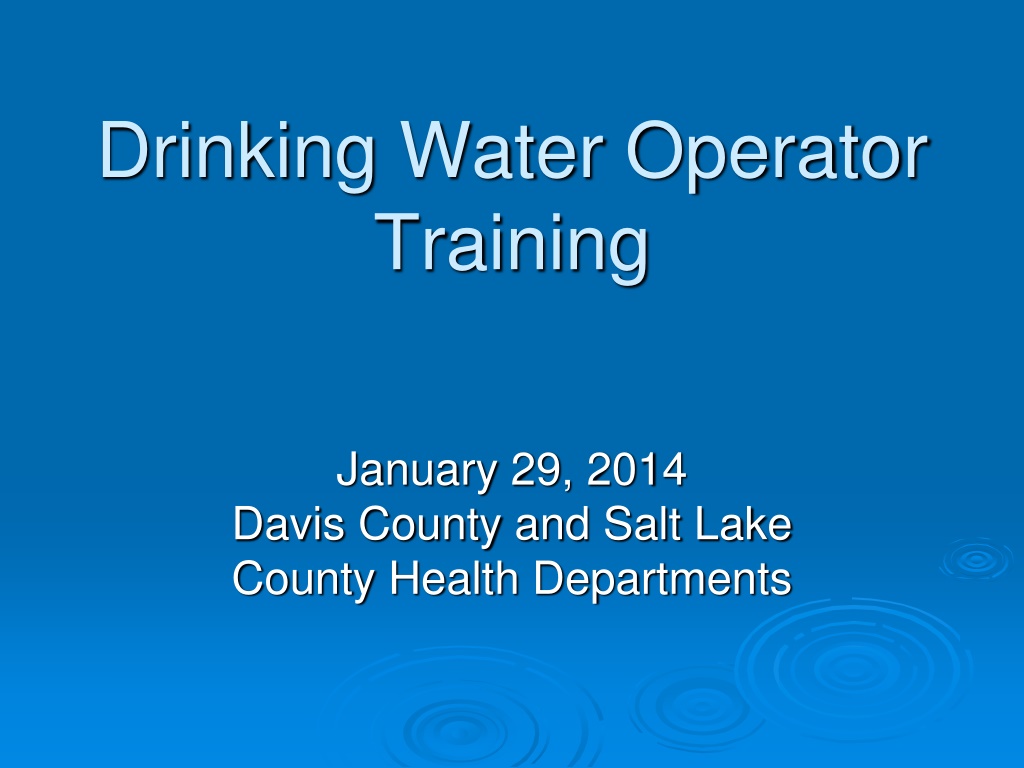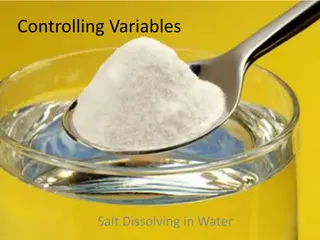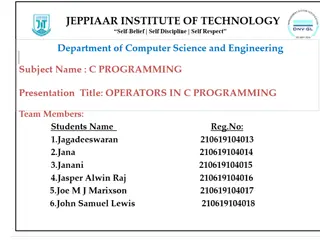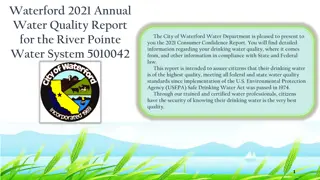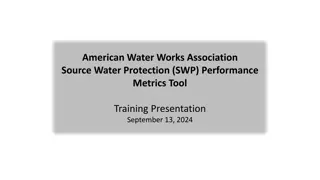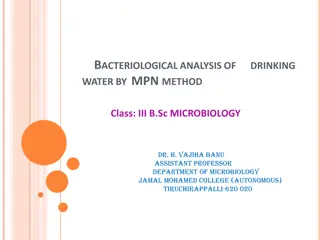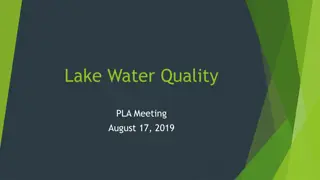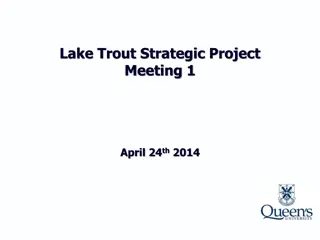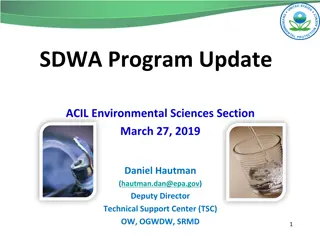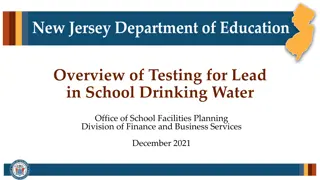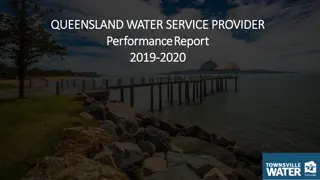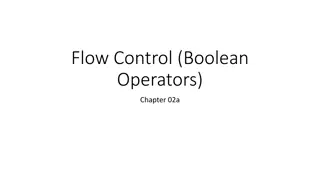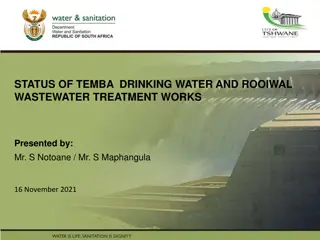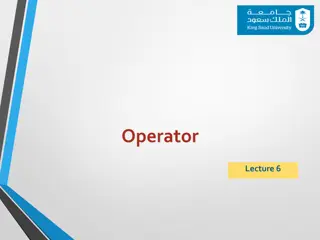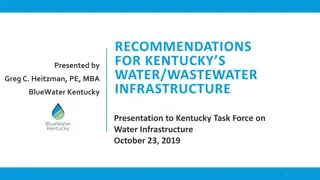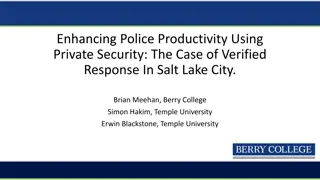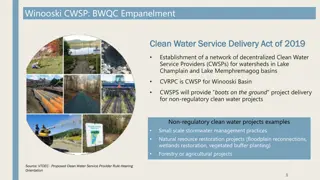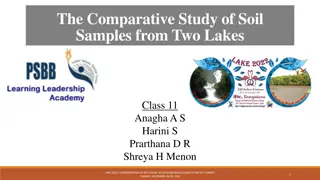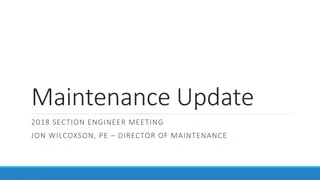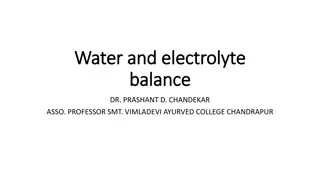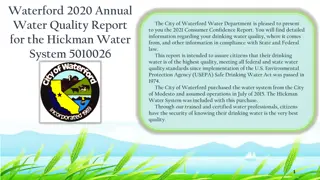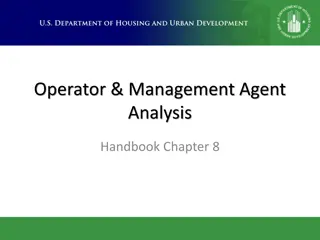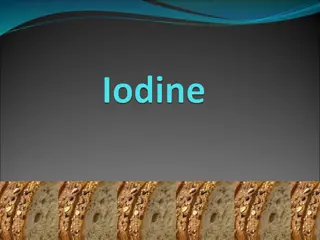Management of Drinking Water Operators in Davis County and Salt Lake County
Davis County and Salt Lake County Health Departments oversee drinking water operator training, fluoride regulation history, and monitoring processes. This includes setting optimal fluoride levels, conducting regular surveillance, and ensuring compliance with regulations.
Download Presentation

Please find below an Image/Link to download the presentation.
The content on the website is provided AS IS for your information and personal use only. It may not be sold, licensed, or shared on other websites without obtaining consent from the author. Download presentation by click this link. If you encounter any issues during the download, it is possible that the publisher has removed the file from their server.
E N D
Presentation Transcript
Drinking Water Operator Training January 29, 2014 Davis County and Salt Lake County Health Departments
Salt Lake Valley and Davis County Health Departments Fluoridation Regulations Overview/History Fluoride Levels Reporting/Monitoring Operator Safety Underfeeds/Overfeeds Training
A Little History.. November 2000: Davis County voted in favor of water fluoridation September 4, 2001: Regulation signed into effect Set optimal level at .9 control range: .8-1.4 mg/L November 2004: Davis County again voted in favor of water fluoridation February 8, 2005: Revised Regulation signed into effect An attempt at more uniformity with SLCoHD June 2007: Revision of optimal level of fluoride Set optimal level to .8 control range .7-1.0 mg/L
A Little History.. November 2010, The Annual Control Range was changed: Davis- 0.6 to 0.8 mg/L with an annual average of 0.7 mg/L. 0.6 - 0.7- 0.8 SLVHD- 0.6 to 0.9 mg/L with an annual average of 0.7 mg/L. 0.6 - 0.7- 0.9
A Little History.. August 13, 2013 Better defines training requirements and requires that documentation of training be submitted to the County by the 15thof January of each year.
Powers and Duties of Local Health Departments Responsibilities Require fluoridation at Optimal Levels Require submission of reports of fluoride addition and analysis Provide Fluoride Surveillance The regular review of monitored data and Split Sample results to ensure that fluoride levels are maintained by the Public Drinking Water Supply Distribution samples (in addition to required Water Supply s samples)
Monitoring (Davis) Sampling Daily, at representative points in the Distribution System When there are several zones or areas, the sample sites can be rotated from day to day, providing the entire system is covered in one week (Davis). Monthly Split Sample Ensures accurate testing equipment
Split Samples One sample is split One sample is analyzed by field kit used for compliance sampling One sample is submitted to the lab for laboratory analysis These samples should be within 20%. If not, a repeat is required. If still not in the range, let s evaluate any potential issues!
Investigative Samples (Davis) Results of samples collected by Davis County Health Department may also be taken into consideration to determine compliance. Minimum 2 samples/month/system (Davis) Investigative samples are processed in our NELAC/State certified lab.
Compliance Compliance is determined by taking the annual average of the field tests results taken by water system Split sample results and the calculated dose support the validity of the field test results
2013 Fluoride Compliance Averages (Davis) 0.90 0.80 0.70 0.60 0.50 0.40 0.30 0.20 0.10
Monitoring (Salt Lake) Fluoride concentrations, including natural and added fluoride, need to be recorded daily. Weekly samples must be taken at representative locations through out the distribution system Systems meeting the annual control range may reduce sampling to twice/month and each site A monthly Split Sample result (for equipment calibration verification) must be submitted with the monthly report
Investigative Samples (Salt Lake) The investigative samples are analyzed by SLCoHD and serve as secondary verification of fluoride concentration throughout the system. Several samples are taken each month throughout the county at random locations
2013 Fluoride Average Salt Lake County 0.9 0.8 0.7 0.6 0.5 0.4 0.3 Series1 0.2 0.1 0
Pocket Colorimeter, Fluoride Analysis Only does fluoride SPADNS Method Factory calibrated Be aware of interfering substances
Fluoride Analysis Materials needed: Colorimeter kit Distilled Water Beakers Standards may be used to check for accuracy.
Some notes on using this method (SPADNS): Samples may be stored in glass or plastic for at least 7 days when kept refrigerated. Watch expiration dates of reagents
Some notes on using this method (cont.): SPADNS reagent contains enough arsenite to eliminate up to 5 mg/L chlorine Aluminum may be an issue for surface treated water Be sure that your meter is not getting any error codes when turned on and reagents are fresh and in good condition. DI water quality is very important, when testing for Fluoride first step in troubleshooting is trying another source of DI water
Some notes on using this method (cont.): Cleanliness of sample cells is very important Keep these items for fluoride use only. Acid wash cells after use (1:1 HCL) and rinse three times with DI water and air dry Temperature of sample and DI water must be the same temperature differences will affect results. Also reagent temperature should be the same.
Some notes on using this method (cont.): If you are pipetting , both the reagent and the sample must be pipette pipetting errors cause the most errors in results. It is technically possible to get tighter results using the pipetting procedure However many customers are able to get tighter results by switching to the AccuVac method which is less technique sensitive. Bulk SPADNS can be contaminated . Contamination is eliminated with the AccuVac.
Fluoride Compounds and Application Equipment Plan Reviews, Evaluation of Fluoride Equipment, Fluoride Compounds, Chemical Feed Equipment and Methods Refer to Rules for Public Drinking Water Systems, R309-535-5. Fluoridation. Fluoride Chemical Standards AWWA standards and/or ANSI/NSF Standard 60
Does this meet AWWA standards and/or ANSI/NSF Standard 60 ???
Operator Safety References Refer to R309-525-11 Chemical Addition, Division of Drinking Water Refer also to R315-9 Emergency Controls, Environmental Quality, Solid and Hazardous Waste Refer also to R614 Labor Commission, Occupational Safety and Health
Operator Safety (continued) The Material Safety Data Sheet (MSDS) Should be posted at all chemical injection sites Spill Response Recommended Disposal Health Hazard Data First Aid Special Protection Storage
Storage of Fluoride Compounds Prevent cross contamination Allow enough room for storage Separate other chemicals from fluoride chemicals Keep dry chemicals dry! Bags and drums shall be stored on pallets
Liquid Chemical Storage (fluorosilicic acid) Tanks must: Have an overflow and a receiving basin or drain capable of receiving accidental spills or overflows, Fluorosilicic acid must not be allowed in the storm drains or sanitary sewer. Vent any unsealed fluorosilicic acid containers to the atmosphere
Accidental Release In the event of an uncontained or accidental release to the environment in excess of five gallons, operators are to follow the Accidental Release Measures instructions found on the MSDS. notify the Department within 24 hours.
Liquid Spills Use spill control pillows or dams to contain liquid from spreading Neutralize with lime Avoid flushing to public sewer or on-site septage (septic tank) system
Overfeed Requirements Public notification may be required if fluoride levels reach 2.0 mg/L Public notification is required if fluoride levels reach 4.0 mg/L
Overfeed Requirements If over 2.0, notify Health Department and supervisor. Determine malfunction/repair If over 4.0, if malfunction is not found, immediately turn off fluoridation equipment, sample throughout distribution system. After repairs are complete, with supervisor s permission, restart If over 10.1, as above, but restart system with both Health Department and Supervisor approvals
Underfeed Requirements For less than 2 weeks: No action needed if equipment is off line For 2 weeks - 6 months: Contact the Health Department in writing with a proposed plan of action and an anticipated correction date by week three.
Required Training A minimum 6 hour training course must be taken before operation of fluoridation equipment Training includes: Operator safety Maintenance/operations Fluoride chemicals Regulatory requirements
Required Training An ongoing training must be taken every 2 years A 3 hour course that includes: Operator safety Regulatory updates/reviews Operations/maintenance
Training Possibilities All day course typically every year though AWWA WBWCD, usually every year CDC 6 hour training on CD (contact me for a copy) Water Fluoridation: Principles and Practices, in Sacramento fall course in Murfreesboro, TN Thatcher
CDC-Sponsored Water Fluoridation Training Water Fluoridation: Principles and Practices CDC Sponsored course Murfreesboro, Tennessee: usually in September each year, dates have not yet been announced Sacramento, California: February 11 to February 13, 2014 http://www.cdc.gov/fluoridation/engineering/tr aining.htm
http://www.cdc.gov/mmwr/PDF/rr/rr 4413.pdf
Contact Information Davis County Davis County Fluoride Regulation: http://www.daviscountyutah.gov/documents/heal th/environmental//fluoridation_regulation.pdf Dee Jette: 801-525-5111 deejette@co.davis.ut.us Angie Jones (reports) 801-525-5115 ajones@co.davis.ut.us For spill reporting call EH emergency phone @ 801-807-8872 (after hours, emergencies).
Contact Information Salt Lake County Fluoride Regulation: http://www.slvhealth.org/envRegs/reg33flouridation.html Lili Benavidez: 385-468-3898 libenavidez@slco.org Submit monthly reports to drinkinwatersamples@slco.org For spill reporting after hours and weekends call Emergency Response # 801-580-6681
